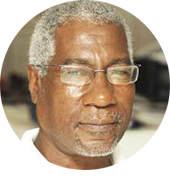
Covering the lead to the first 100 Days of the Ukraine conflict was quite an experience for journalists expecting fair-and-balanced reporting by the international media houses covering a serious quarrel between neighboring states that quickly escalated into a fight after being fanned and inflamed by third parties with wider and deeper interests.
The war actually started before the first Russian tank entered Ukraine’s Donbas region, or the first shot was fired.
The United States, European Union (EU) and the US-led North Atlantic Treaty Organization (NATO), alongside and through the mainstream international media, started an unveiled propaganda war against Moscow and President Vladimir Putin, long before Russia’s February 24 incursion-by-invitation into Donetsk and Lugansk, two territories in modern Ukraine where Russian-speaking majorities had for eight years been accusing the government of persecuting them for continuing to identify with Russia, a former fellow state in the then Union of Soviet Socialist Republics (USSR).
As soon as it became clear Russia wasn’t going to take lying-down the plans to extend NATO troops to bordering states and have Ukraine join the military alliance, the European and American media drew their own lines in the sand and launched unprecedented joint propaganda offensives against President Vladimir Putin and the Russian state.
Leading to the February 24 Russian incursion, the major international media houses covering the conflict shared an unhidden and unholy alliance in one-sided coverage that ignored and dismissed all Russia’s “national interest” and “self-defense” arguments, instead portraying Putin and Moscow as new imperial European aggressors bent on seizing Ukraine to expand territory and re-establish the ‘Soviet Empire…’
After Russia’s parliament recognized the two breakaway Donbas provinces as new republics, the new narrative was that Putin had pulled-out Russia’s ‘Playbook for Invasions’.
But Putin made it absolutely clear Russia would not pull brakes until and unless it got guarantees of no further expansion eastward by NATO — and mainly, that Ukraine will not join the alliance and station hostile troops, including US forces, on its direct border.
Ukraine’s President Volodymyr Zelensky was quite hesitant and doubtful in the weeks leading to Russia’s February 24 incursions, downplaying Western claims Moscow was “about to invade Ukraine” by raining bombs on its major cities and calling on citizens to wave flags and sing in the streets, instead of hiding in bunkers as recommended by the US and European defense experts talking to the mainstream international media.
Western intelligence sources continued feeding the major mainstream media with select information supposedly predicting how Russia’s “invasion playbook” tactics would play-out in Ukraine, starting with so-called “False Red Flag Operations” to justify planned attacks.
Accusing President Zelensky of “ignoring” Western intelligence reports, the US and NATO officials told the international media houses covering the gathering storm that the Russians had indeed planned to “invade Ukraine” on February 21.
When the February 21 “invasion” didn’t happen, the narrative moved to Germany halting certification of the ‘Nordstream 2’ pipeline delivering essential gas supplies from Russia and the UK having imposed sanctions against five Russian banks.
When the predicted February 21 invasion didn’t happen, Russia, as then President of the UN Security Council, appealed at a special related meeting for the US and Europe to give the requested assurances regarding NATO expansion eastward and Ukraine’s membership of the US-led European military alliance.
But the US and UK, European Union (EU) and NATO, all insisted Russia should recognize and live quietly with Ukraine’s sovereign right to join NATO and the alliance’s right to expand closer to Russia’s borders in the name of protecting member-states against Russia – but all the time ignoring Russia’s similar right to be concerned about its own security in the face of hostile military encirclement.
The next new narrative was that Russia’s entry into Lugansk and Donetsk represented “the biggest military catastrophe since World War II” and all needed to be done by Europe and the USA “to prevent Putin from reconstituting the Russian empire…”
Ukraine was also being given false military comfort by the Western media, with claims it “has an anti-tank weapon for every Russian tank…”
Putin had called a press conference in mid-February in which he questioned why the US was pressuring the new Sholz administration in Germany to abandon the ‘Nordstream’ pipeline projects that were commercial and not political projects important to Europe and reliably delivering gas at five to seven times less than competitors.
The Russian president insisted Moscow wanted guarantees of equal consideration for its security concerns and recalled that “NATO’s bombing of Belgrade was not sanctioned by the UN Security Council…”
But by February 18, the US Defense Secretary and the Polish Defense Minister held a joint press conference announcing more US troops to be stationed in the Baltic region – closer to Russia – with Poland already home to the fourth largest number of US troops in Europe.
The first phase of the one-sided international media coverage – before February 24 – presented Putin and Russia as only being interested in “invading Ukraine” and “taking it over” to “enlarge Russia’s territory in Europe” and thereafter to “do likewise with every former Soviet state” on its borders, to re-establish the Soviet or Russian ‘Empire’.
Since Putin has always insisted that the collapse of the USSR was “the greatest mistake of the 20th Century”, the Western media narrative placed him as wanting to be Russia’s new ‘Peter the Great” with expansionist plans that Europe and the US simply had to not just avoid, but prevent.
The fortnight leading to February 24 saw the major US and European media houses interviewing retired American and NATO Generals interpreting Russia’s military moves in parts of Ukraine and offering militarized solutions that would only widen the conflict — and journalists referring to “us” and ‘them”.
Sadly, the holy grail of journalism was thrown to the wind in Ukraine, history and context totally erased — the “why” detached from the “how” and the “when”, with emphasis only on the “who”, “what” and “where”.












